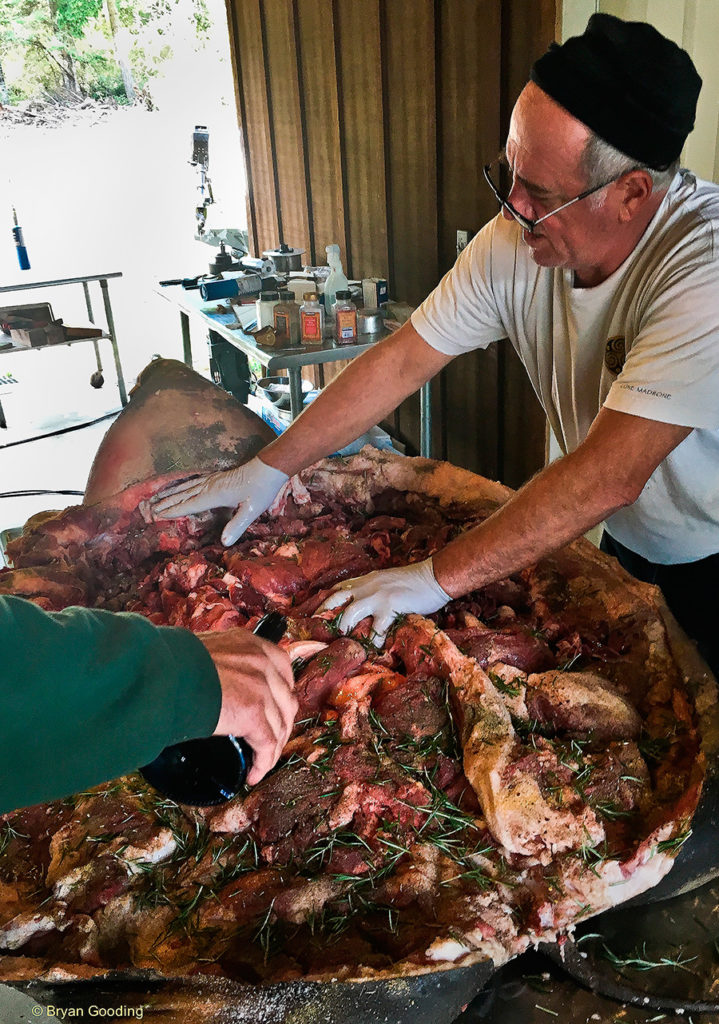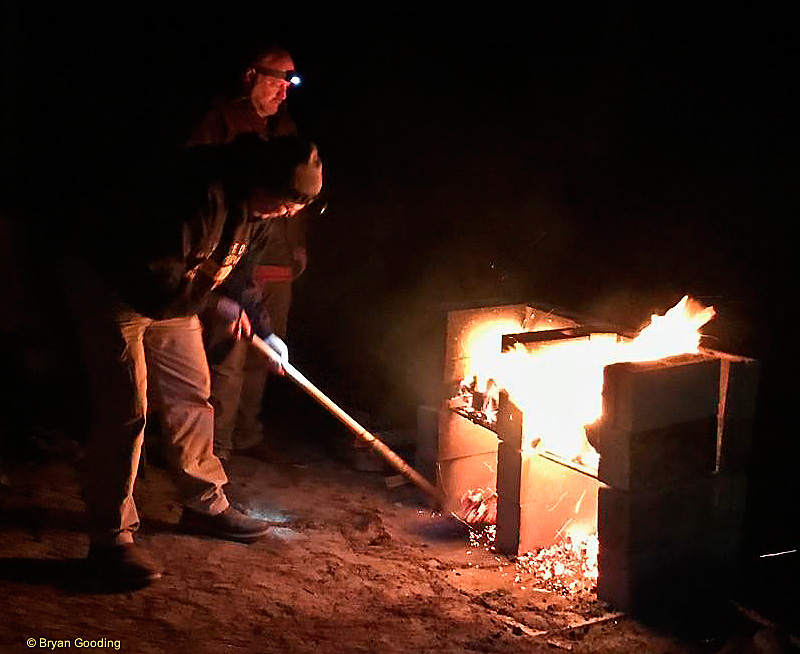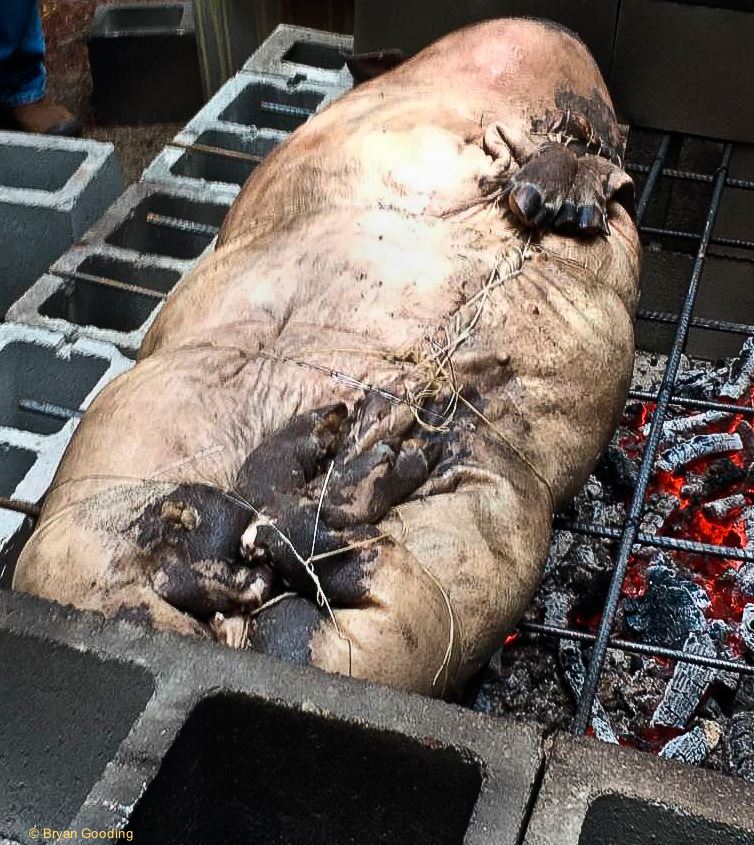
Scenes from the annual “Big Fat Pig Roast” on Lopez Island, Washington. (Photos ©Bryan Gooding)
It is a week and a half into September and the rains we usually see later in the month are here. It is 60 degrees and it feels like fall. In a week we are having a fundraiser for the Lopez Island (Washington) Grange because it is an old building with a history that sorely needs a paint job. The event is called the “Big Fat Pig Roast” and will be a covered dish dinner for 150 locals where the main course will be a two-and-a-half year old Kuna Kuna heritage pig known as Johann.
Kuna Kunas reach maturity at two years and Johann has used his extra six months to pack on the pounds eating a lot of windfall apples here of late. Heritage pigs normally run smaller than the commercial breeds and a mature Kuna Kuna can get to about 200 pounds. Johann is estimated at 275.
Robin Gibson has asked to have some time this morning to be with Johann and has insisted that she will do the dispatch herself. When I arrived at 10 she was ready and calmly put Johann down. I jumped in to help Robin while David Gibson stuck the neck and we wrestled Johann’s back end up so he could bleed out.

Setup for scraping and slaughtering the pig. (Photo ©Bryan Gooding)
I think it is easier to build an Egyptian pyramid than getting a 275-pound pig into the bed of a pick-up. The Gibsons have a small farm and no tractor. Every time we handle the pig from now until he rested on the cutting table at the Grange would require four healthy people with no history of back problems.
From the farm we moved the pig up the hill for scraping and slaughtering. Our set-up consisted of a neighbor’s tractor, a smoker with a 55 gallon barrel of water heating on top of the firebox, an old bathtub sitting on cinderblocks plus the utensils necessary to scrape and gut a pig.
Once a pig is killed you need to be ready to either skin or scrape it as quickly as possible. We wanted to roast our pig so we were planning on scrapping before gutting. Scrapping involves getting the water in the barrel up to 150 degrees. The hair on a hog comes off quite easily after a five-minute dip in water that hot. Our Jim Birkemeir on the tractor said that farmers know the water is hot enough if they can quickly dip their hand in twice but not a third time.
We put the pig on a gambel (a metal device that is run thru the tendons of the rear legs). The gambel is then attached to the tractor scoop which is raised above the tub where the pig is dipped for 5 minutes. Once removed the scrappers jumped in and quickly began scraping the hair off with cups (saucer shaped blades mounted on a handle similar to a bell).
After scrapping the pig is gutted, reserving the liver and kidneys. The tub was emptied and cleaned. It was then moved into the garage where we prepared a brine of salt, sugar, apple vinegar, apple juice, and large branches of rosemary and bay. All this was then covered in ice. Thus Johann reposed for two days.

Kuna Kuna heritage pig Johann is moved up the hill for processing. (Photo ©Bryan Gooding)
Ciro and the Day of Peaceful Cutting
I met Ciro for the first time at the Friday evening wine tasting at Vita’s. I had seen him before at events around the island. He always showed up with homemade bread and a jug of his wine. Originally from Italy he was an oceanographer. When he arrived in Seattle he discovered there were very few positions for his background whereupon he opened a bakery and started a very successful cracker company.
When I mentioned cooking a large pig, Ciro suggested deboning it then filling it with herbs and spices. Once filled, then sewing it up for cooking. He volunteered to do the butchering himself if I could show up with three helpers to move and hold the pig.

Ciro works on deboning and stuffing the pig before being sewn up and placed on the smoker. (Photo ©Bryan Gooding)
Tuesday morning and again the usual team of four suspects removed the pig from the tub, loaded it into the truck and unloaded it at Ciro’s. The setup at Ciro’s is amazing. He has two small buildings with a common roof over a concrete dog run between the buildings. In one building is his kitchen, pantry, and utensils. In the other are several large glass casks holding 30 gallons of wine each, a couple of oak casks and several homemade prosciutto hanging from ceiling joists. Cured meats hang from various racks and the smell of wine yeast wafts through the air.
Ciro was raised on a farm in Italy and it was there he watched the traveling butcher at work. There would be a helper, and a large suitcase that held the knives used. It was a quiet process with very little talking as the helper and butcher knew the process so well they rarely had to speak. To paraphrase Ciro - “It was a time of peaceful cutting.”
The whole process from power washing the pig to sewing it up took five hours. It was a quiet process. Ciro wanted no distraction, few questions, and total focus. All the bones except the skull were removed. Bones were picked clean and the meat was add back into the pig for cooking.
Since Johann was a very mature pig and had added six months of extra fat, we removed about half of the fat throughout. The extra meat was added back into the carcass and the interior was rubbed with salt, pepper, fresh rosemary, garlic and brandy. The skin was then sewed shut with butcher's twine and then girdled with stainless steel line.
After the pig was wrapped for transfer Ciro brought out a prosciutto mounted in a cutting stand and a jug of wine. Offering a glass he said, “Now we must celebrate.”
A Rested Pig and Pit Building
Ciro felt better pork would result from resting for a couple of days. Refrigerating something that weighs 250+ pounds definitely was outside the realm of a regular refrigerator. Fortunately the local noodle bar had a walk-in cooler and enough extra space to squeeze us in. It was epic to see four grown men wrestle a pig into a small walk-in cooler.
While the pig rested, unfortunately, we could not. I had recently watched Aaron Franklin’s excellent episode on roasting a pig in a cinderblock pit. Ours would have to be much larger and, in a departure from the Franklin model, I decided to build fireboxes at either end of the pit to roast stereophonically. This would cook the pig from both ends with a central flue having less concentrated heat directly under the pig.
The center grate was made from half-inch rebar resting in notches cut in the cinderblock running east/west and north/south. The crosshatch of rebar was then wired together. Our pit lid was three-quarter inch plywood with a covering of aluminum sheet on the inside. In our test run we found holding the heat at 200 degrees F was doable.

Stoking the fire during the 15-hour cook on the cinder block pit. (Photo ©Bryan Gooding)
The 27 Hour Countdown
Saturday morning was another drizzlefest as we met at the noodle bar to retrieve Johann before customers showed up. The pig pulled out a lot easier than it went in. We had removed the upper wall on one side of the pit so the pig could be slid rather than dropped in since hot coals were already in place covering the entire bottom of the pit.
We were shooting for a very hot start to sear the skin and possibly get some chicharrones. Once placed on the grate we sealed the open side and covered for the cook. While we were hoping for 500 degrees F we only got as close as 375.

The stuffed pig slowly cooks on a cinder block smoker. (Photo ©Bryan Gooding)
Thus began an around the clock burning of fir firewood for coals to keep the pit at 200 degrees F. Starting at 11 a.m. Saturday until 2 p.m. Sunday. The only incident was a fat fire that evening which resulted from a large pool or fat that had collected on the downhill side of the pit. This was easily put out using sand and a brick fire block that kept the pool from reaching the firebox again.
At 2 p.m. we quit stoking the fires and began the cool down, cracking the lid to let heat escape. Then at 4:30 we removed the side of the pit again to slide out the pig, which we transferred to a homemade plywood litter for easy carrying. The carrier also served as a cutting board at the party.
Party Time
I’m not exaggerating when I say Lopez Island has some of the best covered dish dinners around. All the farms and fresh ingredients make it easy for a cook to create something fresh and healthy.
When we planned the party we were shooting for 150 guests with a $10 per person donation. We had a Cajun band volunteer to provide music for a meal. Activities included Piggo (bingo using cuts of pork), pin the tail of the pig, pie contest, and polka contest.
We had the pig at the Grange half an hour before party time and as I cut the stitches a cloud of steamy aromas emerged. The meat was still a little too hot to touch. Using heavy rubber gloves I scooped heavy chunks of pork dripping in fat out of the hard shell of Johann. In the end we had about 20 pounds of pork for leftovers, 160 well-fed guests and memories of Johann.

Guests dig in at the “Big Fat Pig Roast” held at the Grange on Lopez Island. (Photo ©Bryan Gooding)

Author Bryan Gooding pulls pork at the “Big Fat Pig Roast” held at the Grange on Lopez Island. (Photo ©Bryan Gooding)







